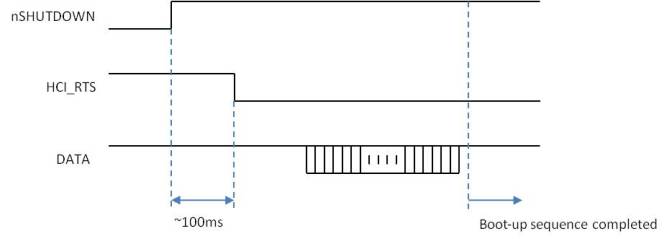SWRU437B September 2015 – June 2020 WL1801MOD , WL1805MOD , WL1807MOD , WL1831MOD , WL1835MOD , WL1837MOD
9.6.1 Bluetooth UART HCI Interface
- The Bluetooth subsystem is controlled via an HCI 4-wire UART interface (H4).
- Verify that the HCI interface is connected as shown in Figure 8. Note that a TX pin always routes to a RX pin, and a RTS pin always routes to a CTS pin.
- FUNC1_BT should be NC.
- FUNC2_BT should be NC.
- In case of host processor I/O is at 3.3 V, use a standard 245 level shifter and not a direction sensing one. For more information, see Level Shifting WL18xx I/Os (SWRA448).
- Once Bluetooth EN is asserted to high the Bluetooth FW stored in ROM start to execute, during this time the RTS is driven high to prevent HCI transaction and not to interfere with device boot, once the FW finish the boot process RTS line goes low after approximately 100 mS.
- Connect HCI Tester and Set Baud Rate - 115200, Data Bits - 8, Stop bits -1, Parity - none, Flow Control - HW. On this port, send basic HCI commands (BD Address) to verify connectivity.
- In case UART lines are not operating, make sure that the CTS line is set to 0 on the PC side - the signal on the WiLink Rx input line that comes from the PC (on the port Probe).
 Figure 8. HOST HCI UART Interface
Figure 8. HOST HCI UART Interface Table 8. HCI UART Interface Lines
| Pin Number | Name | Type | Description |
|---|---|---|---|
| 41 | BT_EN | I | Bluetooth Enable |
| 50 | BT_HCI_RTS | O | Bluetooth HCI UART request to send output |
| 51 | BT_HCI_CTS | I | Bluetooth HCI UART clear to send input |
| 52 | BT_HCI_TX | O | Bluetooth HCI UART transmit output |
| 53 | BT_HCI_RX | I | Bluetooth HCI UART receive input |
NOTE
In the AM335x integration reference, the RTS and CTS lines are crossed, as shown. For some of the other processors, the RTS/CTS lines must be connected directly.
If logger is configured at this point, WiLink should print boot up message.
 Figure 9. Bootup Sequence Complete
Figure 9. Bootup Sequence Complete For every packet on Rx, there should be a response on the Tx line from WL18xx.